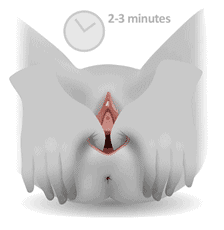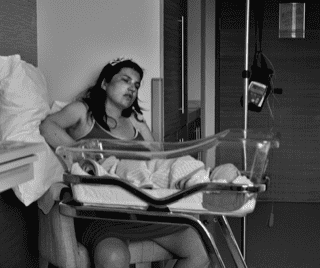Perineal Massage
Cheryl Samuels
Midwife, Co Project Lead at All4Birth
BSc Midwifery,
Summary
Perineal massage is generally not an openly talked about topic, but it can help to reduce your likelihood of perineal trauma and ongoing perineal pain, especially if this is your first birth. It can help you to relax, trust your body, and accept the stretching both physically and mentally. We will explore what perineal trauma is and explain how to massage your perineum.
The chance of you having some degree of perineal trauma during labour are quite high. About 4 to 8 out of every 10 women who give birth vaginally will have some degree of tear and about two‐thirds of these women will need some stitches.2 The chances are higher if you are expecting your first baby, up to 9 in 10 first-time mothers who have a vaginal birth will have some sort of tear, graze or episiotomy.5
What is perineal trauma?
First- and second-degree perineal tears are the most common types, which affect the skin and muscle and are unlikely to cause long-term problems. Third- and fourth-degree tears, which involve trauma to the anal sphincter, occur in around 3-4% of all vaginal births. This degree of tear can cause long lasting or permanent damage to the area and incontinence. There is often no clear reason why this happens, and it is not possible to predict.4, 6 However, it is more likely if:
- This is your first vaginal birth
- Your baby is over 4kg (9lb)
- You have a long second stage of labour (the stage during which you push your baby out)
- Your baby’s shoulder gets stuck behind the pubic bone (shoulder dystocia)
- You have an instrumental vaginal birth (forceps or vacuum assisted).6
An episiotomy is a cut by a health care professional with consent, into the perineum and vaginal wall to make more space for your baby to be born. Local anaesthetic will be injected into the area first to minimize any discomfort. This is done in preparation for an assisted vaginal birth or if there are concerns with your baby’s heart rate close to being born in the second stage of labour. It is possible for an episiotomy to extend and become a deeper tear.5
What are the benefits of perineal massage?
A Cochrane review in 2014 of four trials (2497 women) showed that perineal massage, undertaken by the woman or her partner (for as little as once or twice a week from 35 weeks), reduced the likelihood of perineal trauma (mainly episiotomies) and ongoing perineal pain. The impact was clear for women who had not given birth vaginally before but was less clear for women who had. In conclusion the recommendation is that all women should be informed about the benefits of digital antenatal perineal massage.2
A holistic viewpoint from Weleda suggests that perineal massage will help the woman to relax, trust her body, and accept the stretching – this is not just about physically stretching the perineum. It can also be helpful if during the stretching process the woman says to herself: “I am opening myself up for my child to be born, and I have an infinite amount of space to offer.” The pregnant woman is not just a physical body that needs to be stretched; her emotions and mindset are part of a whole that changes during pregnancy, during childbirth, and throughout her life. The bodily sensations triggered by massaging the perineum can help the woman to have a positive attitude: “I accept this stretching and tingling. My child has plenty of room.” With this information stored in her brain, the woman will be guided through the final phase of childbirth with a relaxed and confident attitude.1, 3
How to massage your perineum during pregnancy
- Warm bath
Sit in a warm bath before you start. This may help you to relax before the massage and loosen the muscles around your perineum. - Short nails
The tissues in your vagina and perineum are very delicate. Make sure your hands are clean and nails are short to prevent scratching the skin, or any discomfort to the area. - Comfortable position
You need to be relaxed during the massage, so it is important you find a comfortable position. Most people find lying in bed the most comfortable, supported by pillows. But experiment and find a position that is most comfortable for you. - Lubricant
Use a lubricant like Weleda Perineum Massage Oil (See details below). - Gentle massage
Insert your fingers or the hook of your thumb 2cm into your vagina and gently massage the lower half of your vagina using a U-shaped movement, from 3 – 9 o’clock for around 2-3 minutes. - Thumbs
Hold your thumb or both thumbs if you can reach, into the position shown for about 1 minute (diagram below). Press down towards the anus and to the sides of the vagina walls. Hold your thumbs in this position for about 1 minute. You will begin to feel a tingling and stretching sensation. Breathe deeply. Repeat the gentle massage and thumb stretch 2-3 times. - Massage your perineum every day or at least 1-2 times every week from 34-35 weeks of pregnancy.4
At first the thumb stretch can feel uncomfortable, but it should feel easier by 2-3 weeks of practice.

Image credit RCOG, 2020.
The benefits of Weleda perineum massage oil
- Increases skin elasticity
- Makes the skin softer and more flexible, reducing the risk of the perineum tearing or an episiotomy during childbirth
- Key ingredients – Oil base: Sweet almond oil • Wheatgerm oil (with natural vitamin E) – increases the skin’s elasticity
- A blend of essential oils of clary sage and rose –
- Rose oil: enveloping, centering, harmonising
- Clary sage oil: relaxing effect on the body tissue thanks to sclareol (which has oestrogen-like components that have a loosening effect on body tissues).
Are there any risks?
During pregnancy do not perform perineal massage if you have any signs of infection, vaginal bleeding or you think your membranes may have broken. Please call your maternity care provider for individual advice.
Summary
Perineal massage can help to reduce perineal trauma, especially for first births by increasing the flexibility of the perineal tissues. The psychological benefits can prepare the mind for the sensations of birth and promote relaxation of the perineal muscles. You or your partner can do the massage and there are no known negative side effects. So why not give it a try?
Links to resources
 Books
Books
The Positive Birth Book by Milli Hill
The Modern Midwife’s Guide To Pregnancy, Birth & Beyond by Marie Louise
 Video
Video
 Websites
Websites
Weleda Perineal Massage – https://www.weleda.co.uk/perineal-massage
References
- American College of Nurse-Midwives. (2016) Perineal massage in pregnancy. J Midwifery Women’s Health. 61(1):143-144. Available from: https://onlinelibrary.wiley.com/doi/full/10.1111/jmwh.12427 [Accessed 10th December 2020]
- Beckmann M, Stock O. (2013) Antenatal perineal massage for reducing perineal trauma. Cochrane Database Syst Rev. (4):CD005123. Available from: Antenatal perineal massage for reducing perineal trauma – Beckmann, MM – 2013 | Cochrane Library [Accessed 10th December 2020]
- Labrecque M, Eason E, Marcoux S. (2001) Women’s views on the practice of prenatal perineal massage. BJOG. 108(5):499-504. https://obgyn.onlinelibrary.wiley.com/doi/full/10.1111/j.1471-0528.2001.00111.x [Accessed 10th December 2020]
- Oxford University Hospitals NHS Trust (2017) Antenatal perineal massage. Available from: https://www.mobhh.ca/wp-content/uploads/How-to-do-Perineal-Massage.pdf [Accessed 10th December 2020]
- National Health Service (2020) Episiotomy and perineal tears – Your pregnancy and baby guide. Available from episiotomy – NHS – NHS (www.nhs.uk) [Accessed 10th December 2020]
- Royal College of Obstetricians and Gynaecologists (2020) Reducing your risk of perineal tears. Available from Reducing your risk of perineal tears (rcog.org.uk) [Accessed 10th December 2020]










